Books about books and books within books
When is a book not a book? When it's a fictional book! Yes, this statement is deliberately confusing, and may not be entirely accurate - read on to untangle fictional books from fiction books!

Some of you may have read The Hazel Wood by Melissa Albert. It’s got a sequel too, The Night Country. If you haven’t read them, they’re both books about Alice who lives with her mother and has spent her whole life moving from place to place trying to avoid bad luck. Some weird stuff happens, her mother goes missing, and Alice figures out that it has something to do with a book of creepy cultish fairytales that her estranged grandmother wrote: Tales from the Hinterland. There are snippets of these fairytales throughout the two books, which are, as I’ve already said, creepy. And fascinating – throughout Albert’s book, everyone who reads these fairytales seems to become an also-creepy-fan of both the stories and their author.
They sound cool, right?! I mean, who doesn’t like the sound of a dark fairytale?
But sadly, you/me/we/the person reading The Hazel Wood never gets to read all these tales in full. At least not in The Hazel Wood, but I’ll get to that later.
Tales from the Hinterland is an example of a book within a book, and in this case, it started out as a fictional book. I’m saying fictional here because when Melissa Albert wrote The Hazel Wood, and created Tales from the Hinterland as something important to the plot, Tales from the Hinterland didn’t exist. She never planned to actually write these tales. The Hazel Wood is a work of fiction, and Tales from the Hinterland was a fictional book within that book.
At least, it was a fictional book until earlier this year when it was released as a real book! (and yes, we do have copies you can get out)
Let’s go over that again. Author writes book about a book. People like author’s book, she writes another. Readers have been interested enough in the book-within-the-book that author and editor decide to make the book in a book a real book.
There, nice and clear, right!?
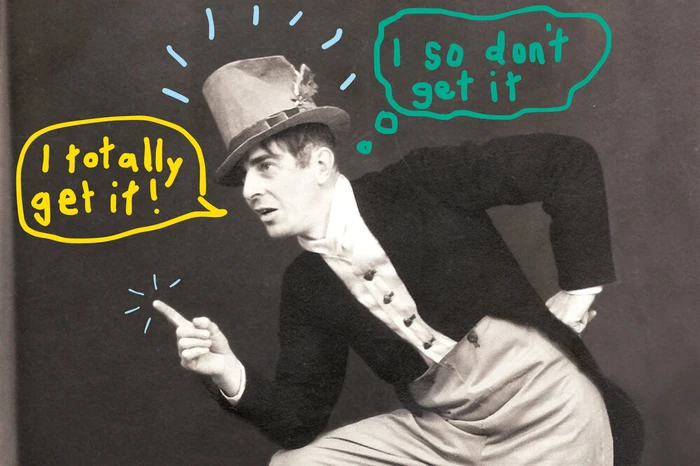
Original image from Wellington City Recollect.
Anyway, it shouldn’t be a surprise that people who write books sometimes also enjoy writing about books. And, in my case, that people who like reading books also like writing about books.
The point of this post is that I want to write about books that don’t exist and books that started off not existing. There are lots of them out there, a few different kinds, some that I wish were real, and some that (like Tales from the Hinterland) eventually became real! And, if you find this as interesting as I do, I want to know which books you’ve read about that you wish were real and you could actually read too!
Let’s get into it! (And don’t worry, I’ll be sure to give you links to the real books in our collection that you can read.)
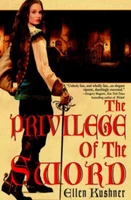
The Swordsman Whose Name Was Not Death This book within a book remains fully fictional. Ellen Kushner has written a short story with the same name, but it’s completely different and is about characters from her earlier book Swordspoint: a melodrama of manners. The Swordsman Whose Name Was Not Death can be found in Kushner’s The Privilege of the Sword and it’s obviously very important. Two characters bond over it, it becomes a play and, in the words of one of the characters, “It’s not trash. It is full of great and noble truths of the heart. And swordfights.” There are a couple of these things in The Privilege of the Sword as well.
From what goes on in The Privilege of the Sword, we know that The Swordsman Whose Name Was Not Death is about the swordsman Fabian who is bound to kill Lady Stella, but upon meeting each other they immediately fall in love, and there is an antagonist in the awful Mangrove with his awful moustache, and also Stella kisses Fabian’s friend Tyrian! And there are many swordfights and a scene with hunting cats on the roof, and it’s all very dramatic. But The Swordsman Whose Name Was Not Death is not a book we'll ever get to read.

So you want to be a wizard This not-real book appears in Diane Duane's real book of the same title. In the real So You Want to be a Wizard, Nita finds the not-real So You Want to be a Wizard at the library. It looks just like one of those other books about a future career, except in this case the career is wizardry. Which is... not a Real Thing. But isn't this such a wonderful idea!? That you can just find a book that has snuck itself onto one of the shelves in a library (an occurrence surely not possible here, due to our diligence and constant shelf-checking), a book that is there specifically looking for you, and that it is there to guide you on your journey to becoming a wizard? It's a book that I think would just be so cool to read for real, because it would mean you were a wizard. For real.
The not-real So You Want to be a Wizard is a fictional non-fiction book, in that in the world of the book that it's in, it's a textbook for new wizards. Come on, that explanation makes perfect sense.
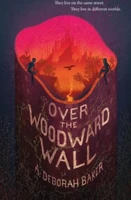
Over the woodward wall
This one’s just like Tales from the Hinterland, in that it was a fictional book within a real book (the real book in this case being Middlegame by Seanan McGuire), until it got written and published a couple of years after Middlegame.
Over the Woodward Wall is one of those weird stories about children who go off on a surreal adventure. Think The Phantom Tollbooth, Alice’s Adventures in Wonderland, The Book of Changing Things and Other Oddibosities. But this one was written by McGuire’s fictional alchemist, A. Deborah Baker, and contains hidden messages about her own agenda and doctrine that she wants to sneak through to future generations of children. There are quotes from Over the Woodward Wall at the start of each Middlegame chapter demonstrating different aspects of this doctrine and if you’ve read both books it’s fascinating seeing how the prewritten snippets of Over the Woodward Wall work their way into the published version.
Middlegame won an Alex Award last year, which is an award for for books that were written for adults but have special appeal for young adults, so make of that what you will.
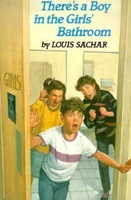
My Parents Didn't Steal an Elephant
Now THIS is a book that I wish I could read! My Parents Didn’t Steal an Elephant, by Uriah C. Lasso (unscramble that name and see what you get) is a book given to the main character Bradley in Louis Sacher’s There’s a Boy in the Girl’s Bathroom to use for a book report.
My Parents Didn’t Steal an Elephant is about an unnamed child who's living with their aunt and uncle because their parents have been (get this!) accused of stealing an elephant. There are excerpts from My Parents Didn’t Steal an Elephant in There's a Boy in the Girls Bathroom that show just how great it is – like when the lawyer gets the child to eat a whole bunch of peanuts real fast so they can say if asked that they can eat fifty thousand peanuts a day. Totally manageable for a child and a normal number of peanuts of have in a house that has no elephants in it at all! (Question: Do elephants actually like peanuts?)
This nonsensical logic is just the sort of thing I like to find in a book, so since you can’t read Uriah C. Lasso’s My Parents Didn’t Steal an Elephant, you might as well go and read Louis Sacher’s Wayside School series for the same sort of fantastic nonsense.
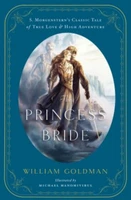
The Princess Bride
“What!” I can hear you saying, “The Princess Bride’s a REAL book/a classic movie!” Well, you’re right. The Princess Bride is a real book by William Goldman. BUT Goldman’s The Princess Bride is, as Goldman writes, merely an abridged version of the Florinese classic of the same name by S. Morgenstern. Except S. Morgenstern does not exist, Florin is not a real place, and the only The Princess Bride is Goldman’s.
S. Morgenstern’s The Princess Bride is a fictional book, that a fictional version of Goldman says is his favourite book from when he was a child (and according to the introduction of the 25th anniversary edition, still is). The fictional Goldman’s father read The Princess Bride to him as a child. Later in life Goldman realised that his father had left out a lot of the boring historical detail, the Morgenstern version wasn’t as exciting and swashbuckling as he remembered, and it was out of print and very hard to find, so he decided to write an abridged version so other people could love it as much as he did.
The Princess Bride by S. Morgenstern is different to the other books in this list because of the way it exists within the world of Goldman’s The Princess Bride. Goldman’s framing of his own novel as a retelling of another fictional narrative is an effective and interesting literary device and is an example of metafictive or self-conscious storytelling.
Ok, that was possibly too much literature-nerd talk. Just know it’s fascinating.
There’s also another fictional book alluded to in The Princess Bride, which is its unpublished sequel Buttercup’s Baby. Some editions of The Princess Bride include a sample chapter of Buttercup’s Baby, but the fictional Goldman informs us that due to legal problems with the Morgenstern estate he has not been able to publish it.
_____________________
So that's a few of the books-within-books that I've come across. There are definitely more - The Hitchhiker's Guide to the Galaxy (the actual guide), Don't Go Out Alone, The Book of the Dead, The Neverending Story, Diseases of the Sheep... but this post is just getting far too long with the books I've already written about.
So now it's over to you. What book within a book do you wish you could read?